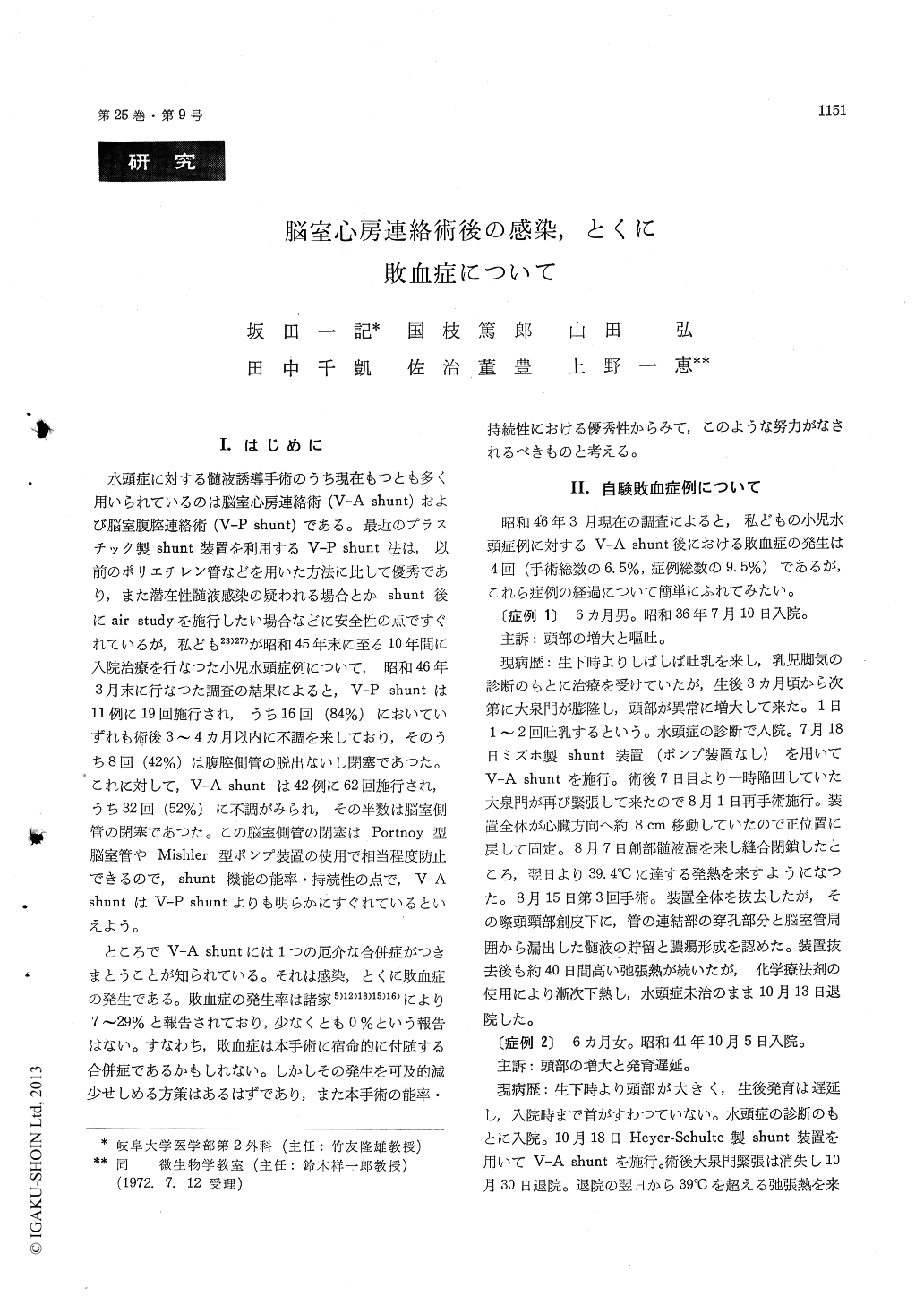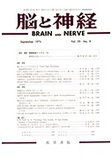Japanese
English
- 有料閲覧
- Abstract 文献概要
- 1ページ目 Look Inside
I.はじめに
水頭症に対する髄液誘導手術のうち現在もっとも多く用いられているのは脳室心房連絡術(V-A shunt)および脳室腹腔連絡術(V-P shunt)である。最近のプラスチック製shunt装置を利用するV-P shunt法は,以前のポリエチレン管などを用いた方法に比して優秀であり,また潜在性髄液感染の疑われる場合とかshunt後にair studyを施行したい場合などに安全性の点ですぐれているが,私ども23)27)が昭和45年末に至る10年間に入院治療を行なった小児水頭症例について,昭和46年3月末に行なった調査の結果によると,V-P shuntは11例に19回施行され,うち16回(84%)においていずれも術後3〜4カ月以内に不調を来しており,そのうち8回(42%)は腹腔側管の脱出ないし閉塞であった。これに対して,V-A shuntは42例に62回施行され,うち32回(52%)に不調がみられ,その半数は脳室側管の閉塞であった。この脳室側管の閉塞はPortnoy型脳室管やMishler型ポンプ装置の使用で相当程度防止できるので,shunt機能の能率・持続性の点で,V-A shuntはV-P shuntよりも明らかにすぐれているといえよう。
ところでV-Ashuntには1つの厄介な合併症がつきまとうことが知られている。それは感染,とくに敗血症の発生である。敗血症の発生率は諸家5)12)13)15)16)により7〜29%と報告されており,少なくとも0%という報告はない。すなわち,敗血症は本手術に宿命的に付随する合併症であるかもしれない。しかしその発生を可及的減少せしめる方策はあるはずであり,また本手術の能率・持続性における優秀性からみて,このような努力がなされるべきものと考える。
Ventriculoatrial shunt operation (V-A shunt) is an efficient method of treatment for hydrocephalus, but a more or less possibility of postoperative in-fection, especially septicemia, cannot be denied. Of our 5 cases (4 infantile hydrocephalus cases and 1 adult brain tumor case) of septicemia followingV-A shunt, 3 had infection primarily in the CSF space, 1 seemed to have infection primarily within the shunting apparatus and 1 seemed to have got infectious endocarditis primarily on account of an injurious effect by cardiac catheter tip movements, as suggested by Nulsen etal15. On the basis of reflection on these cases, preventive measures for post-V-A-shunt infection, especially septicemia were looked for. For prevention of septicemia secondary to CSF infection, V-A shunt should be avoided in cases where occult CSF infection is suspected of and, instead, repetitive ventricular puncture or yen-triculoperitoneal shunt operation should be per-formed in those cases. In order to prevent exter-nal leakage and resultant infection of CSF, dural incision for the ventricular tube insertion should not be too wide and postoperative shunt impair-ment should be avoided as far as possible by pro-per considerations on selection of shunting appar-atus and on operative procedures. No matter howstrictly the operative field is desinfected it appears to be impossible to sterilize deep skin flora comp-letely, therefore contamination of the shunting apparatus by these microorganisms is hardly avoi-ded. Currently we are soaking the entire shunting apparatus into a concentrated antibiotic solution prior to its implantation in patient's body, expec-ting its bacteriocidic effect. Pcstoperative systemic administration of antibiotics is also important. Gas sterilization of shunting apparatus was found to be defective and should be avoided. For prevention of infectious endocarditis consequent to an injuri-ous effect by the cardiac catheter tip, the cardiac catheter should be fixed to the facial vein during operation at such a depth of insertion that its tip is located at the right mid-atrium as the patient's neck is flexed. Treatments for post-V-A-shunt sep-ticemia were discussed.

Copyright © 1973, Igaku-Shoin Ltd. All rights reserved.


